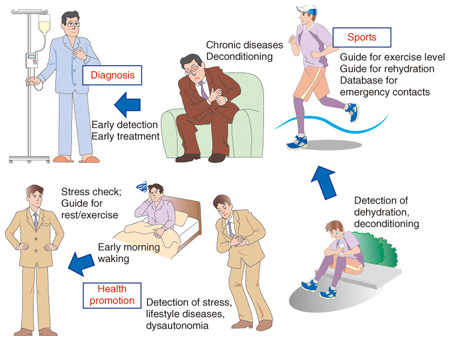 |
|||||||||||
|
|
|||||||||||
|
Feature Articles: Cutting-edge Device and Materials Technologies for Creating New Business Vol. 12, No. 4, pp. 27–33, Apr. 2014. https://doi.org/10.53829/ntr201404fa4 Electrocardiogram Monitoring Simply by Wearing a Shirt––For Medical, Healthcare, Sports, and EntertainmentAbstractWe developed a conductive fiber by coating the surface of silk or synthetic fiber with a conductive polymer and fabricated wearable electrodes to achieve long-term biosignal monitoring. This new bioelectrode made of a complex conductive material is flexible, biocompatible, and hydrophilic and allows stable recording equivalent to that obtained with conventional medical electrodes but without the need for any electrolyte paste, which can irritate the patients’ skin. We can expect this wearable electrode to be utilized in various applications related to sports, health improvement, and early medical diagnosis by providing long-term biosignal monitoring without patient discomfort or irritation. Keywords: wearable electrodes, electrocardiogram, smart textiles 1. Introduction1.1 Biosignal monitoring in daily lifeThe need for early detection and treatment of diseases is increasing as the aging of Japanese society accelerates. Specifically, concern has been rising about the need for continuous, long-term monitoring of electrocardiogram (ECG) data with a view to reducing the risk of sudden death and critical health incidents such as heart attacks. Moreover, people in their 30s or 40s who are in the prime of life are often exposed to excessive stress at the office and/or at home, and monitoring the heart rate (HR) and ECG data is thought to be effective in allowing this group to recognize the state of their physical and mental health in order to maintain it in the optimal condition. However, conventional medical electrodes used for recording ECG signals use electrolyte paste*1, which can cause rashes and irritation. These electrodes are therefore unsuitable for continuous long-term use in daily life. Bioelectrodes based on a conductive fiber that is coated with metal, for example, silver, are often used for measuring HR and have attracted a great deal of interest lately, especially for use during participation in sports since people are becoming increasingly health conscious. However, metal-based conductive fiber, which is usually used without electrolyte paste, can result in a higher noise level because of its instability when it is in contact with skin, and thus, ECG measurement using the conventional electrodes has been difficult for medical applications. 1.2 Newly developed wearable electrodesWe have succeeded in developing flexible, stretchable, and highly breathable (air-permeable) bioelectrodes by coating non-conductive fibers with a conductive polymer material called poly(3,4-ethylenedioxythiophene) poly(styrenesulfonate) (PEDOT-PSS). This material makes it possible to obtain a stable ECG measurement equal to that obtained with a medical electrode without having to use electrolyte paste. This is possible because of the material’s high hydrophilicity, whereby the electrode becomes better attached to the skin by absorbing sweat and steam. We have succeeded in developing wearable electrodes that enable long-term recording of both HR and ECG signals simply by having users wear an electrode-equipped shirt, thus positioning the textile electrodes on the body. These wearable electrodes can greatly reduce the burden imposed on patients or users, and they enable monitoring of everyday biological signals.
2. Complex conductive material made of PEDOT-PSS and textile/fiberPEDOT-PSS is one of the most commonly used commercially available conductive polymers, and it is important in industry as an anti-electrostatic material, an organic photovoltaic material, and a transparent conductive material that is used as an alternative to indium tin oxide (ITO) for touch-panel and flexible LED displays. Moreover, PEDOT-PSS is expected to find use as bioelectrodes because of its high hydrophilicity and biocompatibility. However, its use to date has been limited because of its poor processability and instability in highly humid environments. Our group has used PEDOT-PSS in biosensors to coat metal microelectrode arrays (MEAs)*2 for monitoring in-vitro neuronal activity, and in electrodes for implantation in order to confirm its high biocompatibility and its excellent electrical properties [1]. In our most recent work, we successfully developed a new material by coating textiles or fibers with PEDOT-PSS. This smart-textile, complex conductive material is stable in water and has good processability, thus solving the aforementioned problems. Furthermore, it maintains conductivity, hydrophilicity, and biocompatibility. Coating PEDOT-PSS uniformly onto a silk thread (Fig. 1) gives this compound material the characteristics of both silk fiber and PEDOT-PSS. The base material is not limited to silk fiber, and fibers or textiles made of synthetic material can be coated with the polymer. Thus, we have developed a conductive textile that is flexible, elastic, and air-permeable.
The ECG of laboratory animals (rats) was measured using this complex conductive material (Fig. 2). In the measurement, electric waves were obtained that were as clear and stable as those provided by a conventional medical electrode but without the need to use electrolyte paste [2]. Metal-coated fiber without electrolyte paste gives an unstable ECG baseline due to breathing-related body movement, and it induces noticeable noise as a result of contact resistance with the body surface. By contrast, we were able to obtain a stable measurement using this complex conductive material consisting of PEDOT-PSS and a textile/fiber, because it was effective in absorbing sweat and steam from the body due to its high hydrophilicity, and it adhered gently to the skin thanks to its flexibility.
3. Electrocardiography using wearable electrodesWe took advantage of the characteristics of conductive fibers/textiles to develop wearable electrodes, which enabled us to measure biosignals such as HR and ECG simply by having the patient wear an electrode-equipped shirt. An electric potential distribution is induced in all parts of the body by the electromotive force caused by cardiac activity. An ECG is a wave pattern of the potential difference between two points on the body surface. When the electrode-equipped-shirt is worn, it can provide an ECG because the textile electrode adheres to the skin. The wearable electrodes were jointly developed with Toray Industries, Inc. (Toray), one of the largest fiber manufacturers in Japan. A sample ECG obtained from the shirt in a 10-minute period during 24 hours of monitoring is shown in Fig. 3. This newly developed textile electrode is flexible and air-permeable, does not require electrolyte paste, and is thus capable of monitoring HR or ECG signals over long periods without discomfort or irritation to the wearer.
Before undertaking the joint development with Toray, we fabricated our original wearable electrodes to examine the effect of the material on human skin and the capacity for performing electrical biosignal measurements. We used 82 healthy male volunteers employed at the NTT Atsugi R&D (research and development) Center for our study. We investigated their HRs (R-R intervals) for up to 24 to 48 hours, except when they were showering or bathing. We confirmed that the HR was successfully recorded for more than 10 hours for most subjects, and that the electrode material itself caused no irritation or rash (Fig. 4). In addition, this experiment confirmed that the wearable electrodes provided stable and long-term HR monitoring even during sleep. Thus, the results can also be analyzed to determine sleep quality to promote better health.
In addition, we carried out a skin irritation examination in accordance with OECD (Organization for Economic Co-operation and Development) Test Guideline TG439. We conducted a comparative examination of the survival rate of cultured cells with or without a PEDOT-PSS coating, and found that both survival rates were slightly less than 100%, and that the PEDOT-PSS coating caused no skin irritation. The results revealed that the complex conductive material we have developed makes it possible to undertake long-term electrical biosignal monitoring without safety problems, and the material can be used for wearable electrodes. This experiment indicated that reduced adhesion of the electrode (due to clothing pressure), and dryness of the skin caused noise and signal interception, which had previously prevented long-term HR measurements. The aim of the joint development with Toray of the wearable electrodes was to optimize the material specifications in order to improve the retention of moisture in the skin to ensure adherence of the electrode. 4. Transmitter for ECG monitoringThe electrical biosignals that show the changes in the electric potential of the body surface, measured with the wearable electrode using PEDOT-PSS, are transmitted wirelessly (e.g., using Bluetooth) to a smartphone or personal computer by our own small transmitter attached to the shirt. The device and a sample ECG obtained using the device are shown in Fig. 5. We obtained a high quality ECG with low noise and a high S/N (signal to noise) ratio, and we clearly observed sharp QRS waves*3 as well as P and T waves. The HR is calculated from the intervals between the two peaks of the R waves (R-R intervals). The device is equipped with a lithium-ion rechargeable battery, and the wave pattern can be transmitted continuously for around 12 hours. The electrocardiographic information can be sent to a server via a smartphone from anywhere via the Internet, thus enabling data analysis. We will continue to improve the quality of the wearable electrode system to create new value by combining it with cloud services or big data analysis by further downsizing and reducing energy consumption, and by adding multiple functions to the system.
5. Future applicationsHR and ECG signals can be measured simply by wearing the electrode-equipped-shirt described in section 3. The shirt is soft, flexible, and air-permeable and does not require electrolyte paste. As a result, the shirt can be used to record electrical biosignals without irritating or imposing a burden on the person wearing it. We expect it to be used to support diagnosis leading to early detection and early treatment of illnesses through regular ECG monitoring (Fig. 6). As one key medical ICT (information and communications technology) device application, the device can be studied or used in such medical fields as home medical care or telemedicine. Additionally, the medical quality level provided by wearable electrodes is being studied in cooperation with the medical departments of hospitals and universities with a view to expanding its applications.
The complex electrode material incorporating conductive polymer and fiber/textile that we developed can also be applied to fields other than ECG and HR monitoring. For example, we have examined its applicability to electroencephalographic measurements and to implantation at the research level. The monitoring of changes in HR is also useful in understanding and controlling exercise levels and for improving health care. The wearable electrodes can be used in various settings while the wearer enjoys participating in sports. In addition, the HR normally fluctuates even while a person is resting quietly in bed, and this HR fluctuation can reveal both autonomic nerve functions and stress levels. Thus, HR changes measured with precision by employing an electrocardiographic QRS wave can be useful for calculating the appropriate exercise load as well as for evaluating mental aspects of users quantitatively. These wearable electrodes are effective in supporting mental health care for people of all ages who face various stresses by enabling the daily monitoring of HR changes even while the subject is asleep. Thus, the wearable electrodes can be used for a wide variety of applications ranging from the health and medical field to the sports/entertainment field. We will continue our development with the aim of putting the wearable electrode to practical use while extending our collaborative work both inside and outside the NTT Group companies. References
|
|||||||||||












